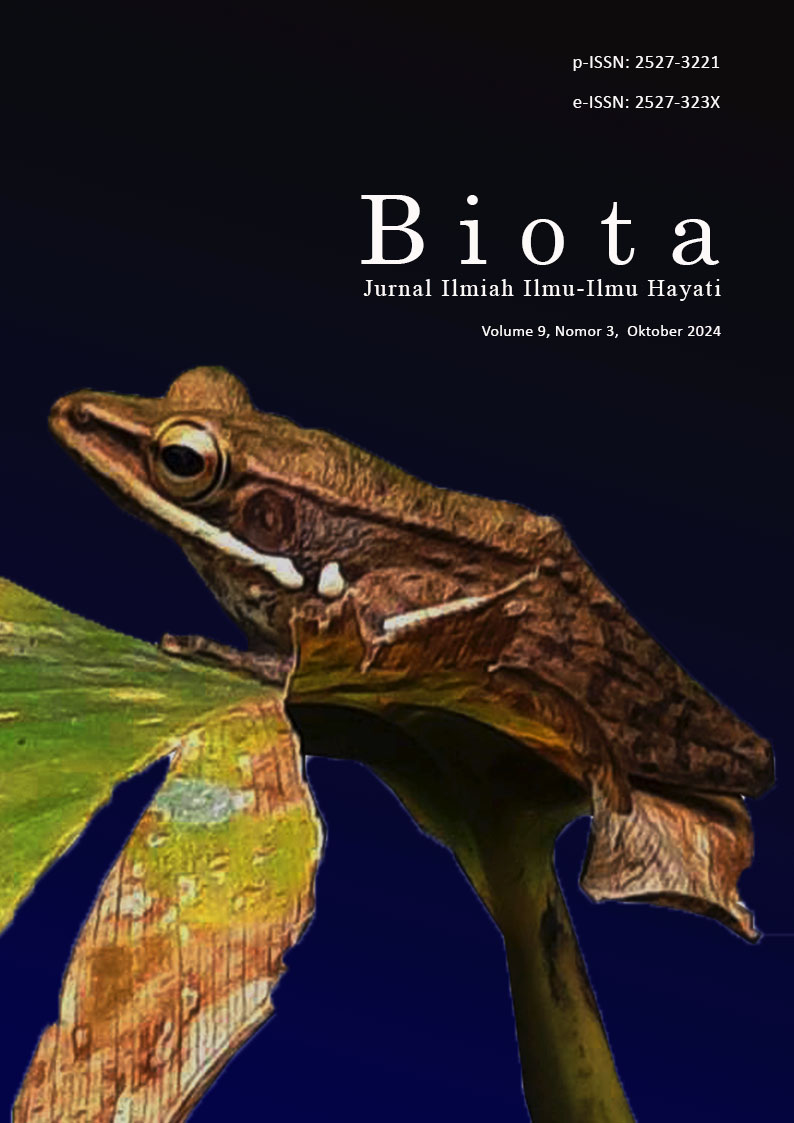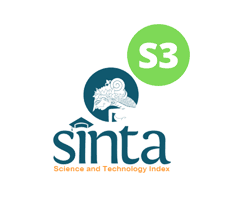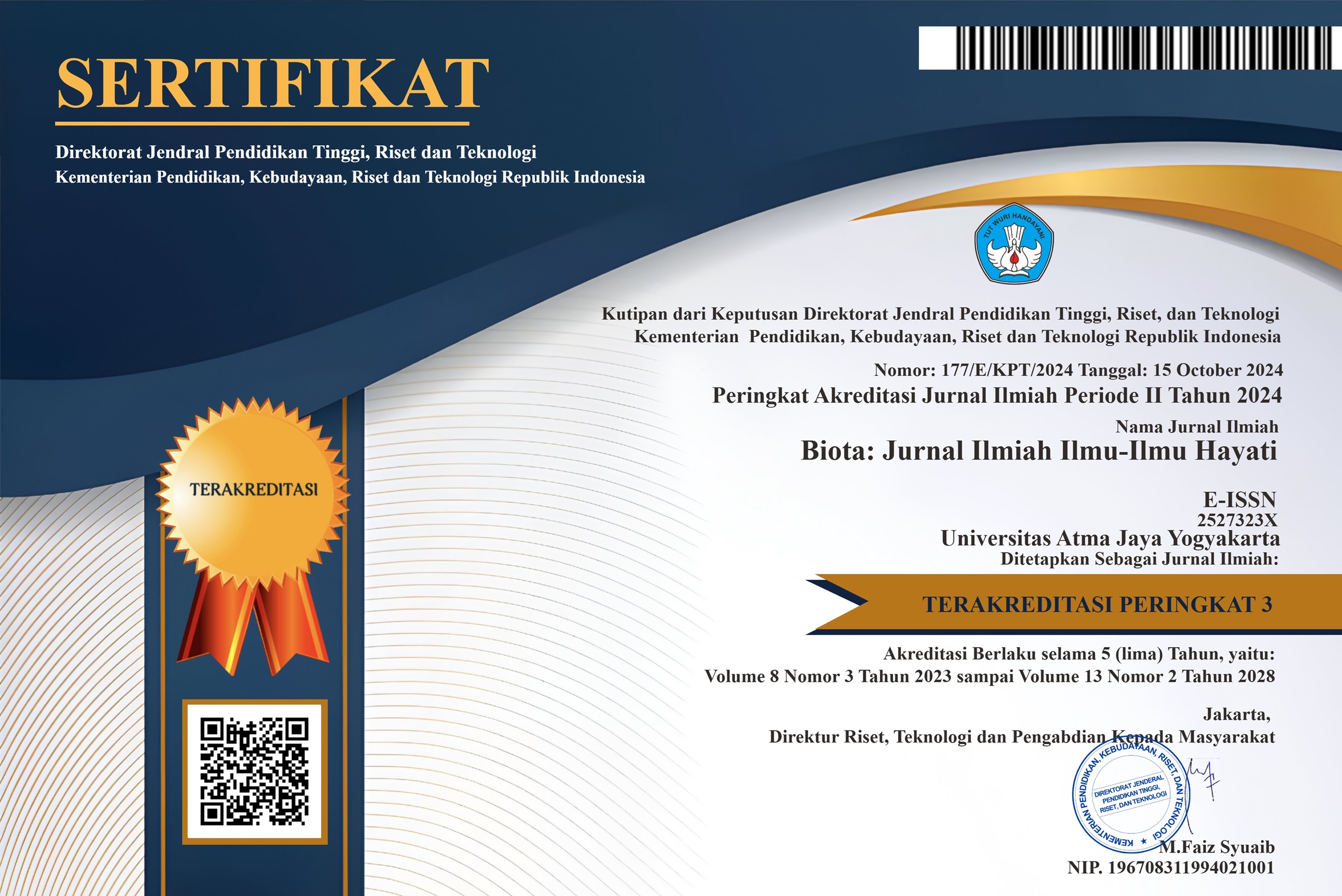Analisis Molekuler Docking Senyawa Daun Sirsak (Annona muricata L.) sebagai Antidepresan Terhadap Reseptor Monoamine Oxidase A
DOI:
https://doi.org/10.24002/biota.v9i3.6619Keywords:
Daun sirsak, in silico, kaemferol, moclobemide, monoamine oxsidase AAbstract
Ketidakstabilan emosi, kesulitan berkonsentrasi, kurang minat pada hal-hal yang menyenangkan, gangguan fisik, cepat menyerah, dan pikiran untuk bunuh diri adalah tanda gangguan jiwa yang dikenal sebagai depresi. Moclobemide salah satu obat antidepresan Monoamine Oksidase Inhibitor, bekerja sebagai inhibitor reseptor Monoamine Oksidase A. Cara kerjanya adalah menghambat reversibel isoenzim MAO-A, sehingga secara khusus meningkatkan kadar neurotransmiter. Penelitian ini bertujuan untuk memprediksi potensi senyawa kaemferol sebagai antidepresan melalui pendektan in silico dengan teknik molecular docking berdasarkan nilai binding affinity pengikantannya dengan reseptor MAO-A. Proses docking yang dilakukam melalui tahap preparasi ligan, uji potensi biooral, uji farmakokinetik, molecular docking, visualisasi hasil docking dan uji toksisitas. Hasil penelitian menunjukkan bahwa moclobemide dan kaemferol berikatan pada residu asam amino yang sama dengan MAO-A pada GLU A: 492 dengan ikatan hidrofobik, dan THR A : 205, ALA A :111, ASN A :125 dengan ikatan hidrogen pada moclobemide. Nilai binding affinity kaemferol -7,5 kkal/mol sedangkan moclobmide -6,3 kkal/mol, Hasil penelitian menunjukkan kaemferol lebih kecil dibandingkan dengan moclobemide, analisis uji farmakokinetik dan potensi bioral juga menunjukkan kaemferol dan moclobemide mampu diabsorbansi, didistribusi, dimetabolisme dan diekskresi. Hal tersebut dapat disimpulkan bahwa kaemferol berpotensi sebagai antidepresan yang aman dikonsumsi secara biooral dan tidak menujukkan resiko yang membahayakan bagi kesehatan, sehingga berpotensi sebagai kandidat obat antidepresan dengan mekanisme menghambat reseptor MAO-A.
References
Adelina, R. (2013). Kajian tanaman obat Indonesia yang berpotensi sebagai antidepresan. Jurnal Kefarmasian Indonesia 3(1): 9–18.
Amberg, A. (2013). In silico methods. In Drug Discovery and Evaluation: Safety and Pharmacokinetic Assays. Springer. Berlin.
Azis, A. (2020). Pengaruh ekstrak kentos kelapa (Cocos nucifera L.) terhadap penurunan immobility time sebagai antidepresan pada mencit (Mus musculus). Jurnal Kesehatan Yamasi Makassar 4(1): 1–8.
Casini, A., Scozzafava, A., & Supuran, C. T. (2002). Cysteine-modifying agents: a possible approach for effective anticancer and antiviral drugs. Environmental Health Perspectives 110(5): 801–806.
Chairunnisa, A., & Runadi, D. (2016). Aktivitas Kalkon terhadap Reseptor Esterogen β (ER-β) Sebagai Antikanker Payudara secara in vitro dan in silico. Farmaka 14(2): 1–8.
Clevenger SS, Malhotra D, Dang J,Vanle B, and IsHak WW. The role of selective serotonin reuptake inhibitors in preventing relapse of major depressive disorder. Ther Adv Psychopharmacol. 2018;8(1): 49-8.
Cramer, G. M., Ford, R. A., & Hall, R. L. (1976). Estimation of toxic hazard—a decision tree approach. Food and Cosmetics Toxicology 16(3): 255–276.
Deng, S., & West, B. J. (2011). Antidepressant effects of noni fruit and its active principals. Asian Journal of Medical Sciences 3(2): 79–83.
Entzeroth, M., & Ratty, A. K. (2017). Monoamine oxidase inhibitors—revisiting a therapeutic principle. Open Journal of Depression 6(02): 31.
Fernando DP, Arciniega M, and Franco JLM. 2018. Molecular docking: current advances and challenges. Publicación Anticipada. 1(21): 1- 23.
Głowacki, E. D., Irimia-Vladu, M., Bauer, S., & Sariciftci, N. S. (2013). Hydrogen-bonds in molecular solids–from biological systems to organic electronics. Journal of Materials Chemistry B 1(31): 3742–3753.
Kroes, R., Renwick, A. G., Cheeseman, M., Kleiner, J., Mangelsdorf, I., Piersma, A., Schilter, B., Schlatter, J., Van Schothorst, F., & Vos, J. G. (2004). Structure-based thresholds of toxicological concern (TTC): guidance for application to substances present at low levels in the diet. Food and Chemical Toxicology, 42(1): 65–83.
Lipinski CA, Lombardo F, Dominy BW, Feeney PJ. (2001). Experimental and computational approaches to estimate solubility and permeability in drug discovery and development settings. Adv Drug Deliv Rev. 46: 3– 26.
Martínez-Vázquez, M., Estrada-Reyes, R., Escalona, A. G. A., Velázquez, I. L., Martínez-Mota, L., Moreno, J., & Heinze, G. (2012). Antidepressant-like effects of an alkaloid extract of the aerial parts of Annona cherimolia in mice. Journal of Ethnopharmacology 139(1): 164–170.
Mooers BH. (2016). Simplifying and enhancing the use of PyMOL with horizontal scripts. Protein Society 25(10): 1873-1882.
Munro, I. C., Renwick, A. G., & Danielewska-Nikiel, B. (2008). The threshold of toxicological concern (TTC) in risk assessment. Toxicology Letters 180(2): 151–156.
Nofianti, K. A., & Ekowati, J. (2019). O-Hydroxycinnamic derivatives as prospective anti-platelet candidates: In silico pharmacokinetic screening and evaluation of their binding sites on COX-1 and P2Y12 receptors. Journal of Basic and Clinical Physiology and Pharmacology 30(6): 20190327.
Nur Y, Cahyotomo A, Nanda, Fistoro N. (2020). Profil GC-MS Senyawa Metabolit Sekunder dari Jahe Merah (Zingiber officinale) dengan Metode Ekstraksi Etil Asetat, Etanol dan Destilasi. J Sains Kesehatan 2(3): 198-204.
Pires, D. E. V, Blundell, T. L., & Ascher, D. B. (2015). pkCSM: predicting small-molecule pharmacokinetic and toxicity properties using graph-based signatures. Journal of Medicinal Chemistry 58(9): 4066–4072.
Pradiningsih, A., Zuniarto, A. A., & Maulana, N. I. (2017). Uji Efektivitas Antidepresan Suspensi Ekstrak Daun Sirsak (Annona muricata, L.) terhadap Mencit Putih Jantan. Pharma Xplore: Jurnal Sains Dan Ilmu Farmasi 2(1): 83–93.
Ruswanto, R., Mardhiah, M., Mardianingrum, R., & Novitriani, K. (2015). Sintesis dan Studi In Silico Senyawa 3-Nitro-N’-[(Pyridin-4-Yl) Carbonyl] Benzohydrazide sebagai Kandidat Antituberkulosis. Chimica et Natura Acta 3(2): 54–61.
Shevlin, M., McBride, O., Murphy, J., Miller, J. G., Hartman, T. K., Levita, L., Mason, L., Martinez, A. P., McKay, R., & Stocks, T. V. A. (2020). Anxiety, depression, traumatic stress and COVID-19-related anxiety in the UK general population during the COVID-19 pandemic. BJPsych Open 6(6): e125.
Suhud, F. (2015). Uji Aktivitas In-silico Senyawa Baru 1-Benzil-3-benzoilurea
Induk dan Tersubstitusi sebagai Agen Antiproliferatif. Jurnal Farmasi
Indonesia 7(4): 243-244
Smith, D. A., Beaumont, K., Maurer, T. S., & Di, L. (2019). Clearance in Drug Design. Journal of Medicinal Chemistry 62(5): 2245–2255.
Taufan, 2020 . Senyawa Aktif, Aktivitas Farmakologi, Dan Mekanisme Kerja Daun Sirsak (Annona Muricata L.) Dan Daun Tempuyung (Sonchus Arvensis L.) Sebagai Antihiperurisemia. Jurnal Farmaka 18 (2):89-94.
Thomas, S., Brightman, F., Gill, H., Lee, S., & Pufong, B. (2008). Simulation modelling of human intestinal absorption using Caco-2 permeability and kinetic solubility data for early drug discovery. Journal of Pharmaceutical Sciences 97(10) 4557–4574.
Trott O, Olson AJ. (2010). AutoDock Vina: improving the speed and accuracy of docking with a new scoring function, efficient optimization, and multithreading. J Comput Chem 31(2): 455-461.
Qoonita, F., & Daryono, H.T. (2012). Hubungan Kuantitatif Struktur Dan Aktivitas Senyawa Turunan 3-Haloasilaminobenzoilurea Sebagai Inhibitor Pembentukan Mikrotubulus. Acta Pharmaceutica Indonesia, 27, 76-80.
WHO. (2017). Other common mental disorders: global health estimates (Vol. 24). Geneva: World Health Organization.
Downloads
Published
How to Cite
Issue
Section
License
Copyright (c) 2024 Wulan Dari Neng Gumiwang, Sulisetijono, Frida Kunti Setiowati

This work is licensed under a Creative Commons Attribution-NonCommercial 4.0 International License.
Authors who publish with Biota : Jurnal Ilmiah Ilmu-Ilmu Hayati agree to the following terms:
- Authors retain copyright and grant the Biota : Jurnal Ilmiah Ilmu-Ilmu Hayati right of first publication. Licensed under a Creative Commons Attribution-NonCommercial 4.0 International License that allows others to share the work with an acknowledgment of the work's authorship and initial publication in this journal.
- Authors are able to enter into separate, additional contractual arrangements for the non-exclusive distribution of the journal's published version of the work (e.g., post it to an institutional repository or publish it in a book), with an acknowledgment of its initial publication in Biota : Jurnal Ilmiah Ilmu-Ilmu Hayati, and as long as Author is not used for commercial purposes.













